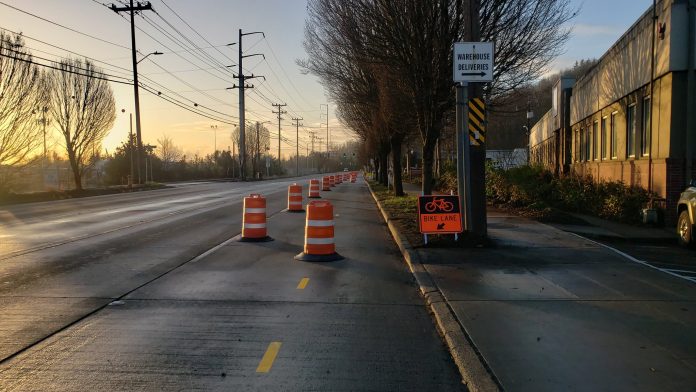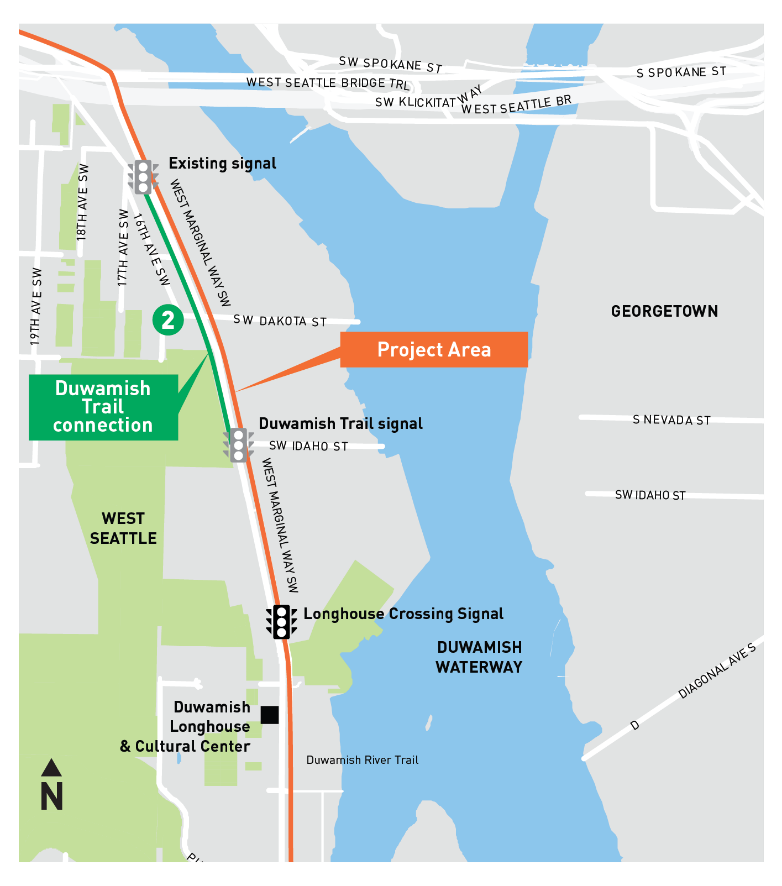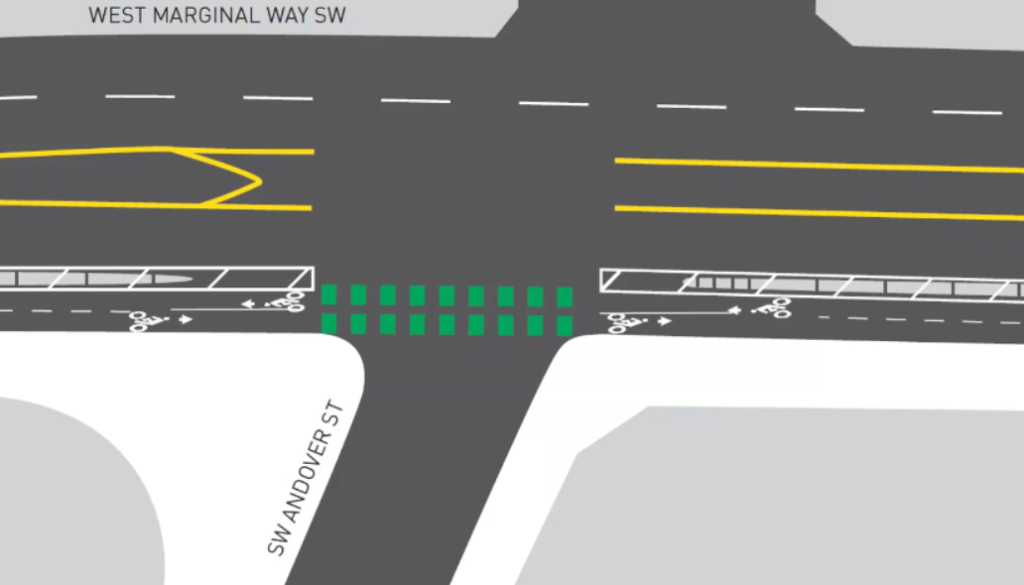
In January, the Seattle Department of Transportation (SDOT) announced that after over two years of planning, it intends to finally install a permanent bike lane along a short stretch of West Marginal Way SW, filling in a 0.4 mile gap that has existed for decades along the Duwamish Trail between West Seattle’s low bridge and neighborhoods directly south. The project was proposed in response to the closure of the West Seattle (High) Bridge in early 2020, as huge numbers of drivers were diverted onto circuitous detours and the City sought to improve routes in and out of West Seattle for people getting around without a car.
Since its inception, the route faced strong headwinds from representatives of the freight sector, who raised concerns about the project reallocating street space on one of the city’s “major truck streets,” with the Port of Seattle in the process of upgrading its Terminal 5 cargo dock near the north end of West Marginal Way. Since 2019, West Marginal has only one southbound lane to improve sightlines and increase safety around the Duwamish Longhouse. It took until 2021 to install a dedicated pedestrian crossing at the cultural center. SDOT’s planned protected bike lane would just extend the single lane further north, making the argument that it would reduce vehicle capacity less tenable.

After the project came under intense scrutiny during meetings of the West Seattle Bridge Taskforce by then-Port Commissioner Peter Steinbrueck, among others, the City signed an agreement with the Port that secured $9 million for the repair of the high bridge. In exchange, the City agreed to hold off on constructing any protected bike lane on West Marginal Way until the High Bridge reopened, among a long list of other stipulations. It also required the city to work with the Port “to ensure the design will maximize safety for all modes and minimize freight impacts on this Major Truck Street.” Now that the bridge has reopened, the Port itself doesn’t appear to be a barrier to construction, but not all freight advocates are ready to give up the fight.
Seattle’s freight advisory board, a cadre of appointees representing various elements of freight-related business interests, had initially been pushing for West Marginal Way SW to be returned to a “five-lane facility” with two lanes in each direction and a center turn lane. The safety project in front of the Longhouse would be removed, a position that hasn’t been reiterated since the board got completely new members in 2022. Even as SDOT heads toward construction of the bike lane, the board is still asking questions about the project, most recently in a meeting in late February that brought out officials from the top of SDOT, Project Development Manager Jim Curtin and City Traffic Engineer Venu Nemani.
At this point, SDOT is completing the final steps of outreach before moving ahead, and not at the point where the project is up in the air… for now at least. “We are committed to building this project,” Curtin told the freight board at the meeting, matter-of-factly. “We would like to build this, and we would like to build this soon.”
The focus now is on the driveways along the street, and whether it is safe to encourage more bicycle traffic along West Marginal by completing the final link to the Duwamish Trail, which has been open since the 1990s. The busiest driveways are not even along the segment where SDOT plans its bike lane along the west side of the roadway, but rather are further south, closer to the SR 99 bridge at 1st Avenue S. The Alaska Marine Lines yard near SW Front Street, the highest-volume driveway along the entire corridor, saw 477 trucks go in and out in one day when SDOT conducted a volume study.

Freight board member Stanley Ryter, a project manager at the Port of Tacoma in his day job, wanted to know whether there was any number of truck or bicycle conflicts that would be considered too many for the project to be safe. City traffic engineer Venu Nemani conceded that perhaps there was a number, but that current conditions do not approach that level. Still, no one is seriously talking about moving the existing trail, and people biking cannot just be directed to use another street, particularly where there is no real alternative to West Marginal. If anything, SDOT’s data suggests that it’s drivers in non-freight vehicles are a bigger safety risk along the street than people biking, with 16 crashes involving trucks and other vehicles in ten years and only one involving someone on a bike.
Most drivers are traveling incredibly fast on West Marginal, many well above the 30 mph speed limit. A weeklong speed study conducted by SDOT found that one out of every four drivers was exceeding 45 mph, with around 75 drivers per day exceeding 60 mph, double the limit.
But last November, when SDOT installed a pilot bike lane along the stretch where the permanent bike lane is planned, the department saw speeds in the adjacent lane drop by around 5 mph — still not at the speed limit, but a striking data point when looking at the overall safety environment on the street with the permanent bike lane. SDOT is now looking at the bike lane as one element of an overall corridor improvement project, with the goal of making other safety upgrades on parts of the corridor that won’t get a bike lane. The lane itself will make everyone on the street safer, at least according to the initial data.

As for the design of the bike lane itself, which has mostly been taking a back seat to discussion of whether it belongs on the street at all, Venu Nemani called the facility “pinched to the absolute minimum” in terms of width, owing to the fact that the other lanes on the street are being kept at their widest to accommodate freight traffic. This is not going to be a facility that sees the same level of bike traffic as the Alki Trail to the north, for example, but SDOT does expect biking and walking traffic to double after the project is implemented.
The compromise from the design standards for a bike lane like this is an indication that the department does recognize the primary designation of the street. It is worth noting that, since the early 1990s when the Duwamish Trail was first completed, a bike facility here was envisioned as enticing people on bikes to check out the Duwamish Valley, though its value will almost certainly be most realized by people already biking to and from the South Park and Highland Park areas.

With the freight board voting in February to send yet another letter to SDOT regarding their thoughts on this very short segment of bike lane, after having already sent two others (when the board was made up of different members), it seems unlikely that their advocacy is going to cause the department to change course at this point. But it speaks to how territorial the freight board is, even with new members, that they aren’t willing to just let SDOT try the project out and see how it goes. Within a few months, hopefully that is actually what will happen.
Ryan Packer has been writing for The Urbanist since 2015, and currently reports full-time as Contributing Editor. Their beats are transportation, land use, public space, traffic safety, and obscure community meetings. Packer has also reported for other regional outlets including BikePortland, Seattle Met, and PubliCola. They live in the Capitol Hill neighborhood of Seattle.

